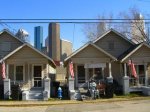Finally I heard an intelligent conversation about gentrification. There was no ax-grinding. There was no embedded bias. There was consistent logic and intelligence applied. I’ve been scanning media and blogs for such a conversation for a long time now so I know how rare this is. (And from a politician, too!) It’s all novel enough that it’s worthy of more than just a re-tweet, so indulge me here in some ramblings and response. And engage with me, please, if you are so moved: as gentrification is a community-wide issue, it warrants community dialog.
For the purpose of this discussion, I’ll define gentrification as I most commonly hear it discussed: a result of market demand or property speculation which increases housing costs and disrupts the social fabric and often the architectural integrity of a community, causing physical and psychological displacement and dislocation to longer-term community members. Antagonisms, a byproduct of gentrification, form along socio-economic lines, along cultural/racial lines and, too, along lines of history, value systems, land use, density and street life.
Texas State Representative Garnet Coleman has been getting press the past few years for an anti-gentrification campaign on the basis of historical and cultural preservation for his district: Houston, Texas’s Third Ward. Recently he was featured in an interview with National Public Radio. Coleman not only represents the Third Ward in the Texas legislature but he was raised there. He points to historical and cultural landmarks of his neighborhood and asks “Why isn’t culture historical?” He cites historic Philadelphia as a model of such preservation. A discussion of cultural value, as opposed land value, is a far more interesting discussion to engage with than the typical bitterness-fueled anti-developer, anti-[name the group], and anti-change anti-gentrification rant which I more often hear. Change is inevitable. The more valid question to me is: can a community help direct the pace, depth and direction of change.

Houston urban neighborhood
Houston’s Third Ward is an area immediately southeast of downtown Houston which developed a vibrant African-America residential and business community despite the many and various mechanisms of overt and institutional racism. The Third Ward is, too, a geographic recordation of redlining – policies which for generations restricted areas in which minorities were allowed to live and own property. Historically, redlining affected not just African-Americans but also Jews, Catholics and immigrant groups.
A corollary in Denver might be the Five Point business district although a historical distinction is that Five Points evolved into, but was not originally founded as, an African-American community center. That is to say, there was a cycle of displacement and resettlement in Five Points, too, in the early nineteen-teens.

Denver urban neighborhood
Neighborhoods see major demo-graphic turnover when one group moves out or when another group shoehorns in. Contemporary urban housing has been through a number of these cycles. In most recent decades: consecutive waves of white flight and then black flight out of the inner city in favor of the suburbs was followed by urban resettlement of the vacancies by “cultural creatives” who, after reinvigorating such population-declining areas are, themselves, pushed out by a gourmet coffee culture and the fatter wallets and more-robust housing expectations that accompany a five-dollar cappuccino .
Coleman has been using tax increment financing tools to combat pervasive gentrification by securing long-term affordability in rental housing and, thus, providing for the preservation of a mix of economic strata despite general rise in housing values. The Third Ward’s Mayor is using deed restrictions and covenants to preserve affordable ownership opportunities. Such sophisticated financial mechanisms aren’t available to the average person on the street. So what does someone living in a gentrifying area do to help preserve their ability to stay in their own home and community? How do us common folk engage with issues of gentrification by means other than throwing stones?
TO BE CONTINUED…
